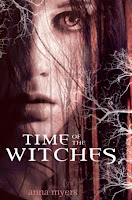 Drucilla has never really had a family of her own. Her mother died giving birth to her in the same room, at the same time, her best friend Gabriel was also being born. His family took her in as their own until they all died in a plague. After that they were inseparable. They bounced from foster home to foster home until, at the tender age of 12, they landed in opposing Putnam households in Salem, Massachusetts.
Drucilla has never really had a family of her own. Her mother died giving birth to her in the same room, at the same time, her best friend Gabriel was also being born. His family took her in as their own until they all died in a plague. After that they were inseparable. They bounced from foster home to foster home until, at the tender age of 12, they landed in opposing Putnam households in Salem, Massachusetts.Dru was taken in by Ann and Thomas Putnam who already had three children of their own. Ann is a strange woman with mood swings that move faster than a flooded river. Dru goes along with whatever Ann says just so she can get along in the household, but she holds on strong to the bond between herself and Gabe.
When the new preacher's family moves to town, Ann forces Dru to spend time with the daughter and niece of the preacher. Too bad they spend a lot of time with their slave Tituba and her witch-based stories. Eventually all this leads to the mass hysteria of the 1692 Salem witch trials. Dru makes her decision to stand with the accusers, believing herself to be a victim as well. That is until Gabe is accused and Dru must decide what's actually real.
I'm a sucker for a good historical fiction. In this case, Anna Myers did plenty of research to make sure her story was authentic. While the book follows the timeline of the witch trials, it is also a touching story about true love and friendship that go beyond the surface. Dru and Gabe are incredible characters facing a heart-breaking reality. They are so easy to relate to and understand. Their actions are those of orphaned children looking to make their way through a tough world. There were no guarantees for anything during this time period and the only thing they could rely on was each other.
While I could get distracted by what was going on in the witch trails and lose track of what was going on with Dru and Gabe, the story always managed to make its way back around to their ordeal. The actions of all the characters were quite consistent with that of the time period and I was surprised by how easy it was to rationalize the hysterical girls' actions. A great read for history buffs or anyone wanting a little respite from modern timelines.
The author brought up a very interesting point as to why she wanted to research the subject. She believes that, had she been one of the girls in Salem, that she wouldn't have been able to withstand the hysteria because her mind is susceptible to suggestion. What do you think? Would you have been the one crying witch or would you have told the truth?


.jpg)






0 comments:
Post a Comment